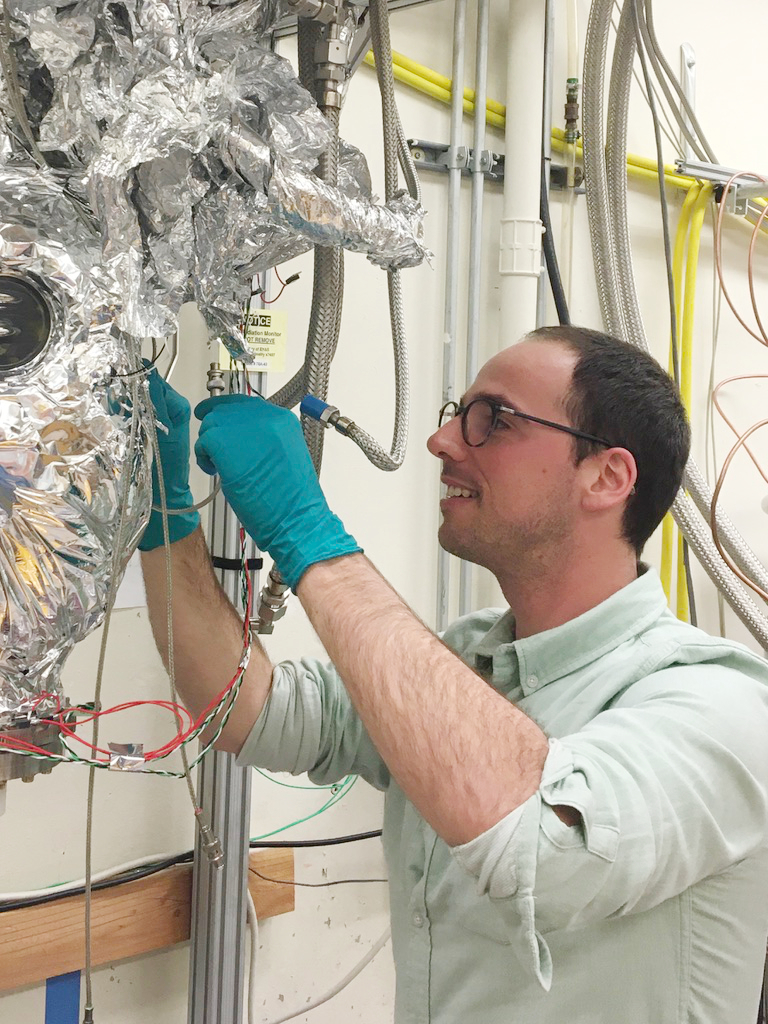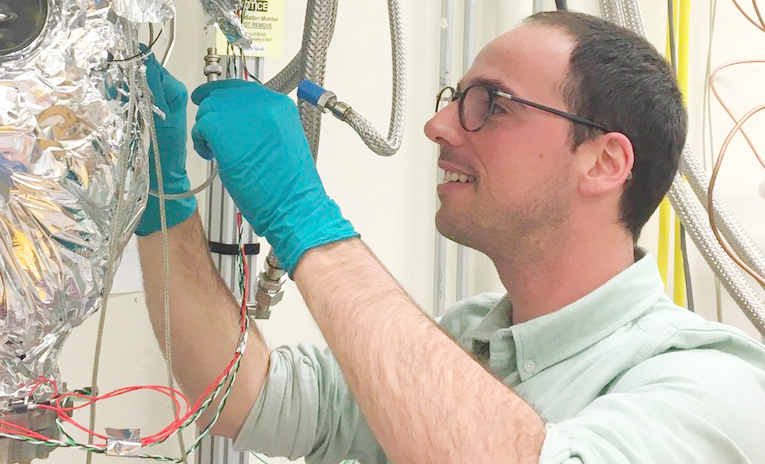
Quentin Riffard works on wiring for the Xenon Breakdown Apparatus (XeBrA), a detector that is designed to study how high voltages affect noble liquids relevant to dark matter searches. (Credit: XeBrA Collaboration)
Quentin Riffard, a project scientist for the LUX-ZEPLIN dark matter detection experiment that is now being installed at the Sanford Underground Research Facility in Lead, South Dakota, shares his experiences in researching dark matter in this Q&A.
Today is Dark Matter Day, which is recognized by the Interactions collaboration, an international particle physics communications group. Dark Matter Day highlights the ongoing efforts to solve one of the biggest mysteries in physics: What is the makeup of dark matter, the large, unseen component of the universe that we know is there only through its gravitational effects and greatly dwarfs visible matter?
Scientists have constructed successive generations of ultrasensitive experiments to determine if dark matter is made of a certain kind of yet-undiscovered particle, a slew of different particles, or whether it may require us to rethink how gravity works.
The LUX-ZEPLIN experiment that Riffard works on is designed to detect the interaction of theorized dark matter particles known as WIMPs, or weakly interacting massive particles, with atoms of liquid xenon.
He has also worked on a predecessor experiment called LUX, and other direct-detection WIMP-hunting experiments including MIMAC and DarkSide that use different approaches than LUX and LUX-ZEPLIN.
Q: What is your personal experience in exploring the mystery of dark matter, and how did you get interested in solving this mystery?
A: I started to work on dark matter as a student pursuing my master’s degree almost 9 years ago and I haven’t left the field. From 2012 to 2015 I worked as a Ph.D. student on the direct detection of dark matter with the MIMAC experiment.
Then I moved to Paris to work as a postdoc for 2 years with the DarkSide collaboration. After this experience I was hired as a postdoc at Berkeley Lab and UC Berkeley to work with the LUX and LUX-ZEPLIN collaborations, and I recently got promoted as a project scientist.
Q: Why is it so important for scientists to better understand the phenomenon of dark matter and what it is made of?
A: Dark matter represents about 85% of the matter of our universe and has a major impact on the evolution of our universe and structure formation. Its existence is supported by a lot of astrophysical observations that are showing gravitationally anomalous behavior that can be explained by dark matter. Based on those observations, we think that dark matter could be a massive particle interaction only through gravitation and the weak force. The weak force is a short-range interaction that happens at the level of the atomic nucleus.
Q: What current and planned dark matter experiments do you think have a good chance for telling us something new about dark matter? And what might they tell us about it?
A: First, there is the Gaia satellite that is measuring the position and the movement of stars in our galaxy. The analysis of those data will shed light on how dark matter is distributed in the Milky Way.
Then, there are LZ and Xenon-nT experiments – the two most sensitive experiments for a direct detection of dark matter. In the case of a positive detection, we will be able to measure its mass and also probe its interaction with matter. By using this information we could validate or invalidate some of the dark matter models created by the theorists.
Q: What new theories about dark matter have captivated your interest, and why?
A: There are many theories that are more or less supported by the current observations. In my opinion, the WIMP is the most promising model. This model proposes a generic massive dark matter particle that interacts only through gravitational and weak forces. This is the kind of particle we are looking for with the LZ experiment.

Click the image to search for Dark Matter Day events in your area or online. (Source: www.DarkMatterDay.com/Interactions Collaboration)
# # #
Founded in 1931 on the belief that the biggest scientific challenges are best addressed by teams, Lawrence Berkeley National Laboratory and its scientists have been recognized with 13 Nobel Prizes. Today, Berkeley Lab researchers develop sustainable energy and environmental solutions, create useful new materials, advance the frontiers of computing, and probe the mysteries of life, matter, and the universe. Scientists from around the world rely on the Lab’s facilities for their own discovery science. Berkeley Lab is a multiprogram national laboratory, managed by the University of California for the U.S. Department of Energy’s Office of Science.
DOE’s Office of Science is the single largest supporter of basic research in the physical sciences in the United States, and is working to address some of the most pressing challenges of our time. For more information, please visit energy.gov/science.
